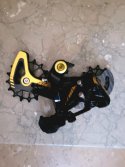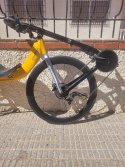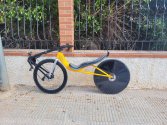My discussion with Mr AI.... impressive
i have had a problem with my front wheel on my bike... the carbon rim hit a pothole too hard and cracked the rim , i am probably going to use epoxy glue to repair the crack.
I'm sorry to hear about the issue with your bike's front wheel. While epoxy glue can be used as a temporary fix, it's important to keep in mind that it may not be a long-term solution.
Carbon fiber is a complex material that requires a specific repair process to maintain its structural integrity. If you're not experienced in repairing carbon fiber, it's best to take your bike to a professional bike shop or a carbon fiber repair specialist to have it inspected and repaired.
In some cases, the damage may be beyond repair, and a replacement wheel may be necessary. It's better to invest in a new wheel rather than risking a potential accident due to a faulty repair job.
emmm i am so irritated by it as i have only had the wheel for less than a year and it cost me 750 euros
I understand how frustrating that can be, especially when you've invested a significant amount of money in your equipment. However, it's important to keep in mind that accidents and damage can happen, especially when cycling on roads with potholes and other hazards.
If you haven't already, you may want to contact the manufacturer or the bike shop where you purchased the wheel to inquire about their warranty or repair policies. They may be able to offer you a solution or repair at a reduced cost or even replace the wheel if the damage is covered by the warranty.
Alternatively, you could also look into purchasing a used or discounted carbon fiber wheel to replace the damaged one, which may be a more cost-effective solution than purchasing a brand new wheel.
In any case, it's important to prioritize your safety when cycling and ensure that your equipment is in good working condition to prevent any accidents or injuries.
Good advice.... yes... i have already tried to contact the company but they havent responded yet.
It's good that you've already tried to contact the company. If they haven't responded yet, you may want to follow up with them to ensure that your inquiry is being addressed.
In the meantime, it's important to take extra precautions when cycling with a damaged wheel. Depending on the severity of the crack, the wheel may not be safe to use at all. If you're unsure, it's best to have a professional inspect the wheel and advise you on whether it's safe to continue using or if it needs to be replaced.
In the interest of safety, it's always better to err on the side of caution and take the necessary steps to address any issues with your equipment.
If i were to use a 30mm bicycle tyre would you have any idea of the psi i would need to pump it up? i weigh 85 kg
The recommended tire pressure for a 30mm bicycle tire can vary depending on a few factors, including the rider's weight, the type of riding, and the terrain.
As a general rule, a good starting point for tire pressure on a 30mm tire would be around 70-80 PSI (pounds per square inch) for a rider weighing 85kg. However, it's important to check the sidewall of the tire itself for the recommended pressure range as it may vary from tire to tire.
If you're planning on riding on rough or uneven terrain, you may want to consider lowering the tire pressure slightly to improve traction and absorb shock. On the other hand, if you're riding on smooth roads or racing, you may want to increase the tire pressure for reduced rolling resistance.
Ultimately, the best tire pressure for you will depend on your personal preferences and riding conditions. Experiment with different pressures to find what works best for you and your riding style.
emmm i probably damaged the rim because my 25mm tyre was 70 psi and i had them lower because of the rough roads around here
Lowering the tire pressure is a good way to improve traction and absorb shock when riding on rough roads. However, it's important to make sure that the tire pressure is not too low, as this can increase the risk of damaging the rim, especially with a carbon fiber rim.
If the tire pressure is too low, the tire can bottom out on hard impacts like hitting a pothole or curb, causing damage to the rim. On the other hand, if the tire pressure is too high, the tire can become less effective at absorbing shock, which can also cause damage to the rim.
As a general rule, it's recommended to keep the tire pressure within the range specified by the tire manufacturer. The recommended pressure range should be printed on the sidewall of the tire. For a 25mm tire, the recommended pressure range is typically around 85-100 PSI for a rider weighing 85kg.
However, if you're riding on rough roads, you may want to lower the tire pressure slightly to improve traction and absorb shock, but not to the point where it's too low and increases the risk of damaging the rim. It's a balance between comfort and safety.
my idea for the future is a 30mm rubber tyre would be a safer and cheaper option
Switching to a wider 30mm rubber tire can have several advantages, especially if you're regularly riding on rough or uneven terrain.
Firstly, wider tires provide better traction and stability on rough roads, which can help to reduce the risk of accidents and improve your overall riding experience. The wider contact patch of the tire also means that it can absorb more shock, making for a more comfortable ride.
Additionally, wider tires can also be more durable and less susceptible to damage than narrower tires. This can be especially true if you're regularly riding on rough or gravel roads, as wider tires can better handle the increased wear and tear.
Switching to a wider tire can also be a more cost-effective option in the long run, as wider tires tend to last longer and require less frequent replacement than narrower tires.
However, it's important to keep in mind that wider tires can also be heavier, which can make it more difficult to accelerate and climb hills. The wider tire may also require a wider rim, so make sure your bike can accommodate the wider tire and rim.
Overall, switching to a wider tire can be a good option if you're looking to improve your comfort and safety while cycling on rough roads. It's important to choose a tire that's appropriate for your riding conditions and to maintain the proper tire pressure to ensure your safety and the longevity of your equipment






